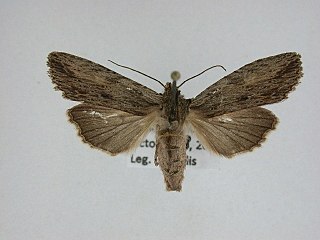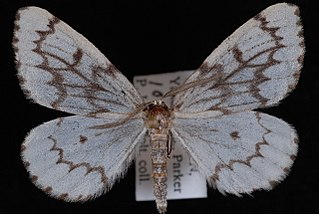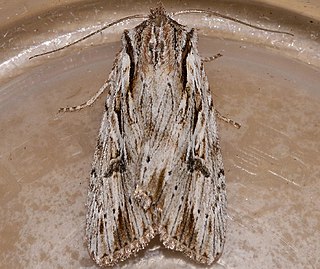Related Research Articles
Nemoria rubrifrontaria, the red-fronted emerald, is a species of moth in the family Geometridae, in the superfamily Geometroidea. The species was described by Alpheus Spring Packard in 1873. It is found in North America.
Tarache terminimaculata, the curve-lined bird-dropping moth, is a species of moth in the family Noctuidae. The species was described by Augustus Radcliffe Grote in 1873. It is found in North America.

Helotropha reniformis, the reniform celaena, is a species of moth in the family Noctuidae. The species was described by Augustus Radcliffe Grote in 1874. It is found in North America.

Lithophane signosa, the signate pinion or sycamore pinion moth, is a species of moth in the family Noctuidae. The species was described by Francis Walker in 1857. It is found in North America.
Plagiomimicus aureolum is a species of moth in the family Noctuidae. It was described by Henry Edwards in 1882 and is found in North America, where it has been recorded from Arizona, western Texas and New Mexico.
Parabagrotis cupidissima is a species of moth in the family Noctuidae. It was described by Augustus Radcliffe Grote in 1875 and is found in North America, where it ranges from southern Vancouver Island, along the Pacific Coast states, to southern California. The habitat consists of grasslands and oak woodlands.
Parabagrotis insularis is a species of moth in the family Noctuidae. It is found in North America, where it has been recorded from southern Vancouver Island, along the Pacific Coast through California to near the border with Mexico. The species was described by Augustus Radcliffe Grote in 1876.

Operophtera danbyi is a species of geometrid moths in the family Geometridae described by George Duryea Hulst in 1896. It is found in North America.
Xestia verniloides is a species of cutworm or dart moth in the family Noctuidae. It was described by J. Donald Lafontaine in 1998 and is found in North America.
Oligia bridghamii, or Bridgham's brocade, is a species of cutworm or dart moth in the family Noctuidae. It was described by Augustus Radcliffe Grote and Coleman Townsend Robinson and is found in North America.
Leucania commoides, the comma wainscot or two-lined wainscot moth, is a species of cutworm or dart moth in the family Noctuidae. It was described by Achille Guenée in 1852 and is found in North America.
Pseudeustrotiini is a tribe of cutworm or dart moths in the family Noctuidae. There are at least three described species in Pseudeustrotiini.

Nepytia phantasmaria, the phantom hemlock looper, is a species of geometrid moth in the family Geometridae. It was described by Herman Strecker in 1899 and is found in North America.

Idaea basinta, the red-and-white wave, is a species of geometrid moth in the family Geometridae. It was described by William Schaus in 1901 and is found in Central and North America.
Zale obsita is a species of moth in the family Erebidae. It was described by Achille Guenée in 1852 and is found in North America.

Meropleon ambifusca, or Newman's brocade, is a species of cutworm or dart moth in the family Noctuidae. It was described by Newman in 1948 and is found in North America.
Lobocleta granitaria is a species of geometrid moth in the family Geometridae. It was described by Alpheus Spring Packard in 1871 and is found in North America.

Xestia infimatis is a species of cutworm or dart moth in the family Noctuidae. It was described by Augustus Radcliffe Grote in 1880 and is found in North America.
Xestia laxa is a species of cutworm or dart moth in the family Noctuidae. It was described by J. Donald Lafontaine and Kauri Mikkola in 1998 and is found in North America.
Tesagrotis corrodera is a species of cutworm or dart moth in the family Noctuidae. It was described by Smith in 1907 and is found in North America.
References
- ↑ "Pseudeustrotia indeterminata Species Information". BugGuide. Retrieved 2018-01-27.
- 1 2 "Pseudeustrotia indeterminata Report". Integrated Taxonomic Information System. Retrieved 2018-01-27.
- ↑ Pohl, G.R., Patterson, B., & Pelham, J.P. (2016). Taxonomic Checklist of the Lepidoptera of North America, North of Mexico
- ↑ "Pseudeustrotia indeterminata, Hodges 9054". North American Moth Photographers Group. Retrieved 2018-01-27.
- Lafontaine, J. Donald & Schmidt, B. Christian (2010). "Annotated check list of the Noctuoidea (Insecta, Lepidoptera) of North America north of Mexico". ZooKeys, vol. 40, 1-239.